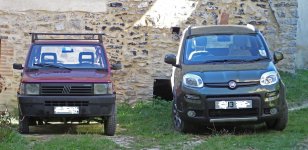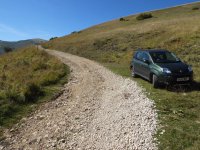babbo_umbro
Established member
We travel between Devon and Umbria twice a year and I keep some notes on how the trip goes. This was the first trip for the 4x4 TA so some reflections may be of interest, remembering that we've also done the same journey in a 100HP and a 1.2 Mk3 in the last few years.
The 4x4 had just over 2000 miles on the clock when we left Devon earlyish on Wednesday 11 September and we covered 1350 miles to arrive near Spoleto on Saturday 15. We've normally taken a day less but my doctor has advised me not to drive for too long for the foreseeable future so we did three overnight stops. The shortest route - via the Channel Tunnel, Lille, Luxembourg, Nancy, Mulhouse, Basle, Milan, Bologna, Florence, Val di Chiana, Perugia, Spoleto - is actually 1250 miles, but a voluntary detour to take in a favourite hotel and an enforced one because the direct route from Basle to the St Gottard tunnel was out of commission added a hundred miles.
The car performed very satisfactorily. Load was two adults and probably 60 kilos of luggage. There are lots of places where cameras make it advisable to observe the speed limits so a good deal of motorway running was at 70 or 80 mph (3200-3700rpm), where the 4x4 was very relaxed with ample reserve of acceleration if needed. Speed crept up to 90 mph (4200 rpm) at times on the autostrada and the car was still well within itself. There's a longish stretch in the Vosges in east-central France on single track, slow roads, climbing the upper Moselle valley and going over the Ballon d'Alsace where lorries dictate that you amble along. I was pleasantly surprised that we averaged just under 42 mpg overall as I'd been getting in the mid-30s previously around Devon. The warmer weather in Italy helped a little but the cold weather all the way till south of the Alps didn't.
Pleased to say that Fiat seem to have sorted the spring and (especially) damper rates out on the 4x4 - supple but well controlled at all times. My test for body control is the stretch of the A1 between Bologna and Florence - quite steep, long climb and descent, dual carriageway with two lanes for most of the way till the never-ending improvements materialise. The lanes are quite narrow, the armco is right alongside the overtaking lane, and the inside lane is full of lorries, some of which are huge; there are numerous long, steepish bends with a very ripply surface, and concrete sections with mis-aligned joints, often oblique to the direction of travel, imparting a jolt to each corner of the car in turn; all this puts a premium on the car giving the driver confidence. The 100HP was not great on this till I put adjustable Konis on the back but the 4x4 was very reassuring, never wallowing but soaking up the bumps. I'm running on the original equipment M+S tyres so experimenting with tyres will have to wait till these have worn, but their 65 section obviously reduces jolts to the occupants. The best way to approach these long quickish bends is to make some definite early steering input to take up the give in the suspension bushes and the squidge in the tyres and to establish the angle of roll - which is not excessive - rather than to be tentative.
Brakes are reassuring under heavy applications from 80-90 mph. Distance between fill-ups is close to 300 miles, though I have to stop to exercise every hour and a half, so this was not a limiting factor for us. The autoroutes in Belgium can be really rough and this was the only place where I ever found the 100HP's ride a bit wearing but the 4x4 was a distinct improvement, swallowing up the worst of the ripples and pot holes with no fuss. The minor roads in our part of Italy are in an appalling state and the 4x4 shows up well here.
The seats are OK on long spells, though not special and somewhat lacking in under-thigh and sideways support.
Finally, the last short stretch is up a steep, white (ie gravel) road, which was distinctly not the 100HP's forte, putting a premium on traction and ground clearance - complete doddle in the 4x4, of course.
In general, traffic conditions weigh so heavily on the rate of progress these days - and, as an aside, the amount of goods traffic was the heaviest I've seen for three or four years, suggesting that commerce in Europe really is picking up - that the 4x4 probably covers this trip in much the same time as the 100HP, though there is not the opportunity to play bears at times and exploit the 100HP's 95 mph cruising speed, or to enjoy its roadholding round those long bends. The two cars are probably different enough to make direct comparisons almost meaningless, with the 4x4 slightly better on mpg. In some ways the 4x4 is more comparable to Mrs b_u's (Mk3) 1.2, with the 4x4 TA superior in every way, except on fuel consumption where the 1.2, working hard on this sort of journey, would give about 45mpg.
The 4x4 had just over 2000 miles on the clock when we left Devon earlyish on Wednesday 11 September and we covered 1350 miles to arrive near Spoleto on Saturday 15. We've normally taken a day less but my doctor has advised me not to drive for too long for the foreseeable future so we did three overnight stops. The shortest route - via the Channel Tunnel, Lille, Luxembourg, Nancy, Mulhouse, Basle, Milan, Bologna, Florence, Val di Chiana, Perugia, Spoleto - is actually 1250 miles, but a voluntary detour to take in a favourite hotel and an enforced one because the direct route from Basle to the St Gottard tunnel was out of commission added a hundred miles.
The car performed very satisfactorily. Load was two adults and probably 60 kilos of luggage. There are lots of places where cameras make it advisable to observe the speed limits so a good deal of motorway running was at 70 or 80 mph (3200-3700rpm), where the 4x4 was very relaxed with ample reserve of acceleration if needed. Speed crept up to 90 mph (4200 rpm) at times on the autostrada and the car was still well within itself. There's a longish stretch in the Vosges in east-central France on single track, slow roads, climbing the upper Moselle valley and going over the Ballon d'Alsace where lorries dictate that you amble along. I was pleasantly surprised that we averaged just under 42 mpg overall as I'd been getting in the mid-30s previously around Devon. The warmer weather in Italy helped a little but the cold weather all the way till south of the Alps didn't.
Pleased to say that Fiat seem to have sorted the spring and (especially) damper rates out on the 4x4 - supple but well controlled at all times. My test for body control is the stretch of the A1 between Bologna and Florence - quite steep, long climb and descent, dual carriageway with two lanes for most of the way till the never-ending improvements materialise. The lanes are quite narrow, the armco is right alongside the overtaking lane, and the inside lane is full of lorries, some of which are huge; there are numerous long, steepish bends with a very ripply surface, and concrete sections with mis-aligned joints, often oblique to the direction of travel, imparting a jolt to each corner of the car in turn; all this puts a premium on the car giving the driver confidence. The 100HP was not great on this till I put adjustable Konis on the back but the 4x4 was very reassuring, never wallowing but soaking up the bumps. I'm running on the original equipment M+S tyres so experimenting with tyres will have to wait till these have worn, but their 65 section obviously reduces jolts to the occupants. The best way to approach these long quickish bends is to make some definite early steering input to take up the give in the suspension bushes and the squidge in the tyres and to establish the angle of roll - which is not excessive - rather than to be tentative.
Brakes are reassuring under heavy applications from 80-90 mph. Distance between fill-ups is close to 300 miles, though I have to stop to exercise every hour and a half, so this was not a limiting factor for us. The autoroutes in Belgium can be really rough and this was the only place where I ever found the 100HP's ride a bit wearing but the 4x4 was a distinct improvement, swallowing up the worst of the ripples and pot holes with no fuss. The minor roads in our part of Italy are in an appalling state and the 4x4 shows up well here.
The seats are OK on long spells, though not special and somewhat lacking in under-thigh and sideways support.
Finally, the last short stretch is up a steep, white (ie gravel) road, which was distinctly not the 100HP's forte, putting a premium on traction and ground clearance - complete doddle in the 4x4, of course.
In general, traffic conditions weigh so heavily on the rate of progress these days - and, as an aside, the amount of goods traffic was the heaviest I've seen for three or four years, suggesting that commerce in Europe really is picking up - that the 4x4 probably covers this trip in much the same time as the 100HP, though there is not the opportunity to play bears at times and exploit the 100HP's 95 mph cruising speed, or to enjoy its roadholding round those long bends. The two cars are probably different enough to make direct comparisons almost meaningless, with the 4x4 slightly better on mpg. In some ways the 4x4 is more comparable to Mrs b_u's (Mk3) 1.2, with the 4x4 TA superior in every way, except on fuel consumption where the 1.2, working hard on this sort of journey, would give about 45mpg.





